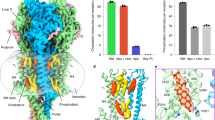Abstract
SOME twenty-five years ago Masland and Wigton1 showed that antidromic action potentials could be recorded from the ventral roots of cats during the muscular contraction provoked by the intra-arterial injection of acetylcholine. As a result of these experiments they suggested that acetylcholine might have an excitant effect on motor-nerve terminals. Later work2 has shown that many other quaternary ammonium compounds have the same ability to provoke antidromic action potentials in motor nerves. In particular Werner2 has shown, by ingenious but indirect means, that these drug effects are not due to excitation of the terminals by synchronous muscle action potentials. Despite these experiments which seem most satisfactorily explained by the presence of some cholinoceptive sites on the nerve terminals3, it has recently been claimed that at the present time there is no direct evidence for an action of acetylcholine on motor-nerve terminals4. This problem is of special interest, for an excitant action of the acetylcholine released by nerve impulses on nerve terminals is the central feature of a new hypothesis of transmitter release at ganglionic and neuromuscular junctions put forward by Koelle5. This excitant action is thought to release further acetylcholine in a sort of positive feed-back action.
This is a preview of subscription content, access via your institution
Access options
Subscribe to this journal
Receive 51 print issues and online access
$199.00 per year
only $3.90 per issue
Buy this article
- Purchase on Springer Link
- Instant access to full article PDF
Prices may be subject to local taxes which are calculated during checkout
Similar content being viewed by others
References
Masland, R. L., and Wigton, R. S., J. Neurophysiol., 3, 269 (1940).
Riker, W. F., Arch. Neurol., 3, 488 (1960). Werner, G., J. Neurophysiol., 23, 171 (1960) ; J. Neurophysiol., 24, 401 (1961).
Eccles, J. C., The Physiology of Synapses, 130 (Springer-Verlag, 1964).
Paton, W. D. M., Canad. J. Biochem. Physiol., 41, 2637 (1963).
Koelle, G. B., J. Pharm., 14, 65 (1962).
Hubbard, J. I., and Schmidt, R. F., J. Physiol., 166, 145 (1963).
Wall, P. D., J. Physiol., 142, 1 (1958).
Ciani, S., Edwards, C., J. Pharmacol., 142, 21 (1963).
Eccles, J. C., The Physiology of Synapses, 78 (Springer-Verlag, 1964).
Author information
Authors and Affiliations
Rights and permissions
About this article
Cite this article
HUBBARD, J., YOKOTA, T. Direct Evidence for an Action of Acetylcholine on Motor-nerve Terminals. Nature 203, 1072–1073 (1964). https://doi.org/10.1038/2031072b0
Issue Date:
DOI: https://doi.org/10.1038/2031072b0
This article is cited by
-
Effect of carbachol on spontaneous transmitter release from rat motor nerve endings depending on extracellular potassium concentration
Neurophysiology (1985)
-
Effect of cholinesterase inhibitors on synaptic potentials of the frog neuromuscular junction
Neuroscience and Behavioral Physiology (1976)
Comments
By submitting a comment you agree to abide by our Terms and Community Guidelines. If you find something abusive or that does not comply with our terms or guidelines please flag it as inappropriate.



